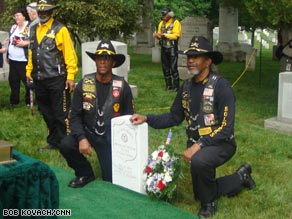
It was a journey that took more than a hundred years.
Missing for decades, the remains of Cpl. Isaiah Mays, a Buffalo Soldier and Medal of Honor recipient, were laid to rest Friday at Arlington National Cemetery. Paying respects were African-American veterans, U.S. Army soldiers and those who rode for days as part of a motorcycle escort — members of the Missing in America Project, who traveled from as far away as California and Arizona at their own expense to make sure Mays got a proper burial. None was a relative but they consider themselves his brothers. They stood shoulder to shoulder in an older section of the cemetery, surrounded by the graves of veterans from wars long ago. Some came in Army dress blue uniforms. Others wore uniforms like those worn by the Buffalo Soldiers, who served in the legendary all-black Army units formed after the Civil War. The crowd stood witness as a color guard folded the American flag and saluted when three rifle volleys pierced the air. A bugler, surrounded by the graves of other fallen heroes, played taps. William McCurtis, the regimental sergeant major of a Buffalo Soldier group, perhaps voiced the sentiment of everyone who came: “One more out of 6,000 has his day of recognition. We need to get the rest recognized.” Mays was born a slave in Virginia in 1858 but spent most of his life west of the Mississippi, joining the famed Buffalo Soldiers as the black cavalry and infantry troops fought in the frontier Indian Wars. In 1889, he was part of a small detachment assigned to protect a U.S. Army pay wagon, which was caught in an ambush by a band of bandits. A gunfight ensued and almost all the soldiers were wounded or killed. Mays was shot in both legs. The bandits made off with $29,000 in gold coins. Despite his wounds, Mays managed to walk and crawl two miles to a ranch to seek help. He was awarded a Medal of Honor on February 15, 1890. More than 20 Buffalo Soldiers have received the Medal of Honor, the military’s highest award for valor. No other unit has won more. Mays left the Army in 1893 and many years later applied for a federal pension. But he was denied. He was committed to an Arizona state hospital that cared for the mentally ill, tuberculosis patients and the indigent. When he died in 1925, Mays was buried in the hospital cemetery in a grave marked only with a number. Years later, a small group of hospital staff and veterans located his grave and arranged for a formal ceremony on Memorial Day 2001. They were determined that Mays should not be forgotten. A few weeks ago, after receiving court permission, volunteers dug up Mays’ remains and transported them from Arizona to Washington so he could be buried with honor at Arlington. After the ceremony, those who gathered to honor Mays posed for photographs and, like good soldiers, they congratulated each other for a hard-won battle. Cpl. Isaiah Mays was finally home.